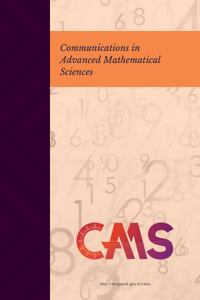Monte Carlo and Quasi Monte Carlo Approach to Ulam's Method for Position Dependent Random Maps
Monte Carlo and Quasi Monte Carlo Approach to Ulam's Method for Position Dependent Random Maps
Dynamicalsystems, Invariant measures, Invariant density, Position dependent random maps, Monte Carlo approach, Quasi Monte Carlo approach Ulam's method,
___
- [1] P. Gora, A. Boyarsky, Absolutely continuous invariant measures for random maps with position dependent probabilities, Math. Anal. and Appl., 278 (2003), 225 – 242.
- [2] M. Barnsley, Fractals Everywhere, Academic Press, London. 1998.
- [3] A. Boyarsky, P. Gora, A dynamical model for interference effects and two slit experiment of quantum physics, Phys, Lett. A., 168 (1992), 103 – 112.
- [4] W. Slomczynski, J. Kwapien, K. Zyczkowski, Entropy computing via integration over fractal measures, Chaos, 10 (2000), 180-188.
- [5] W. Bahsoun, P. Gora, S. Mayoral, M. Morales, Random dynamics and finance: constructing implied binomial trees from a predetermined stationary density, Appl. Stochastic Models Bus. Ind., 23 (2007), 181– 212.
- [6] K.R. Schenk-Hoppe, Random Dynamical Systems in Economics, working paper series, Institute of empirical research in economics, University of Zurich, ISSN 1424-0459 (2000).
- [7] M.S. Islam, Existence, approximation and properties of absolutely continuous invariant measures for random maps, PhD thesis, Concordia University, 2004.
- [8] S. Pelikan, Invariant densities for random maps of the interval, Proc. Amer. Math. Soc., 281 (1984), 813 – 825.
- [9] A. Lasota, J. A. Yorke, On the existence of invariant measures for piecewise monotonic transformations, Trans. Amer. Math. Soc., 186 (1973) , 481– 488.
- [10] S.M. Ulam, A collection of Mathematical problems Interscience Tracts in pure and Applied Math., 8, Interscience, New York, 1960.
- [11] T-Y. Li, Finite approximation for the Frobenius-Perron operator: A solution to Ulam’s conjecture, J. Approx. Theory. 17 (1976), 177 – 186.
- [12] J. Ding, Z. Wang, Parallel Computation of Invariant Measures,Annals of Operations Research, 103 (2001), 283 – 290.
- [13] W. Bahsoun, P. Gora, Position Dependent Random Maps in One and Higher Dimensions, Studia Math., 166 (2005), 271 – 286.
- [14] A. Boyarsky, P. Gora, Laws of Chaos: Invariant Measures And Dynamical Systems In One Dimension, Birkhauser, 1997.
- [15] F.Y. Hunt, A Monte Carlo approach to the approximation of invariant measure, Random Comput. Dynam., 2(1) (1994), 111 – 133.
- ISSN: 2651-4001
- Yayın Aralığı: Yılda 4 Sayı
- Başlangıç: 2018
- Yayıncı: Emrah Evren KARA
Commutable Matrix-Valued Functions and Operator-Valued Functions
Some Characterizations of $h$-Regular $\Gamma$-Hemiring in terms of Cubic $h$-Ideals
On Generalized Fibonacci Numbers
Fidel ODUOL, Isaac Owino OKOTH
Monte Carlo and Quasi Monte Carlo Approach to Ulam's Method for Position Dependent Random Maps
